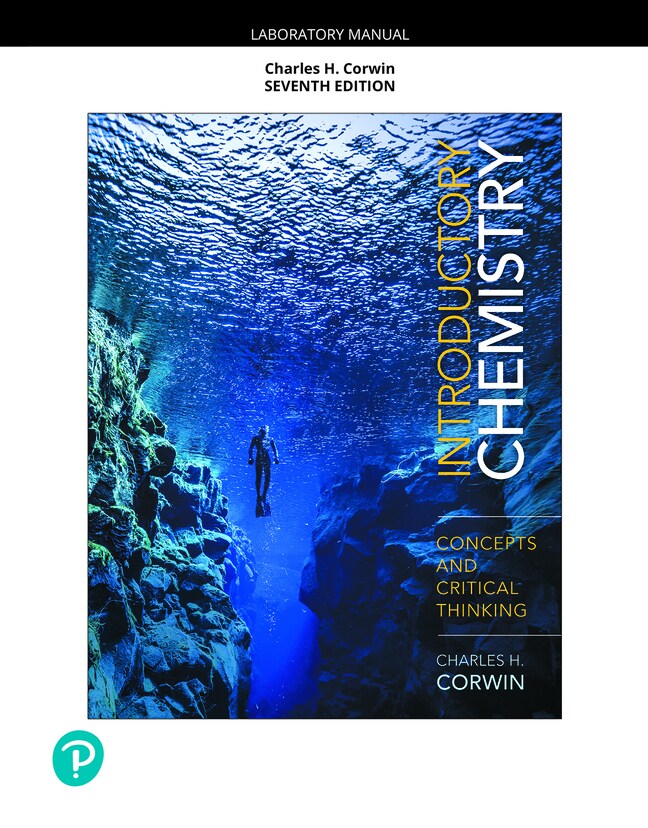
Laboratory Manual for Introductory Chemistry: Concepts and Critical Thinking, 7th edition
- Charles H. Corwin

- Find it fast
Quickly navigate your eTextbook with search
- Stay organized
Access all your eTextbooks in one place
- Easily continue access
Keep learning with auto-renew
Corwin's Laboratory Manual for Introductory Chemistry offers a proven format of a pre-laboratory assignment, a stepwise procedure and a post-laboratory assignment while emphasizing environmental considerations. The lab manual can be packaged with any Pearson Intro Prep Chemistry book.
The 7th Edition continues to evolve with increased sensitivity to environmental and safety concerns. Recycle icons in the margin of each procedure alert students you to recycle chemical waste, and green chemical indicators remind you to use the appropriate waste containers to dispose of chemicals.
Published by Pearson (July 14th 2021) - Copyright © 2022
ISBN-13: 9780137549849
Subject: Chemistry
Category: Introduction to Chemistry
- SAFETY PRECAUTIONS
- LOCKER INVENTORY
- WASTE DISPOSAL
- EXPERIMENTS
1. Introduction to Chemistry
- Topic: The Scientific Method
- A. Instructor Demonstrations
- B. Student Experiments
2. Instrumental Measurements
- Topic: The Metric System
- A. Length Measurement
- B. Mass Measurement
- C. Mass and Volume of an unknown solid
- D. Volume Measurements
- E. Temperature Measurements
3. Density of Liquids and Solids
- Topic: Density
- A. Instructor Demonstration-Density
- B. Density of Water
- C. Density of an Unknown Liquid
- D. Density of a Rubber Stopper
- E. Density of an Unknown Solid
- F. Thickness of Aluminum Foil
4. Freezing Point and Melting Points
- Topic: Change of Physical State
- A. Cooling Curve and Freezing Point
- B. Melting Point of an Unknown
5. Physical Properties and Chemical Properties
- Topic: Physical and Chemical Properties
- A. Instructor Demonstrations
- B. Observation of Elements
- C. Physical Properties
- D. Chemical Properties
6. “Atomic Fingerprints”
- Topic: Emission Spectra and Electron Energy Levels
- A. Continuous Spectrum — White Light
- B. Line Spectrum — Hydrogen
- C. Line Spectra — Helium, Neon, Argon, Krypton, and Mercury
- D. Identifying Unknown Elements in a Fluorescent Light
7. Families of Elements
- Topic: The Periodic Table
- A. Analysis of Known Solutions
- B. Analysis of an Unknown Solution
8. Identifying Cations in Solution
- Topic: Qualitative Cation Analysis
- A. Analysis of a Known Cation Solution
- B. Analysis of an Unknown Cation Solution
9. Identifying Anions in Solution
- Topic: Qualitative Anion Analysis
- A. Analysis of a Known Anion Solution
- B. Analysis of an Unknown Anion Solution
10. Analysis of a Penny
- Topic: Writing and Balancing Chemical Equations
- A. Instructor Demonstrations-Combination Reactions
- B. Decomposition Reactions
- C. Single-Replacement Reactions
- D. Double-Replacement Reactions
- E. Neutralization Reactions
- F. Percentages of Copper and Zinc in a Penny
11. Determination of Avogadro’s Number
- Topic: Avogadro’s Number and the Mole Concept
- A. Calibrating a Dropper Pipet
- B. Calculating Molecules in the Monolayer
- C. Determining Avogadro’s Number
12. Empirical Formulas of Compounds
- Topic: Empirical Formula
- A. Empirical Formula of Magnesium Oxide
- B. Empirical Formula of Copper Sulfide
13. Analysis of Alum
- Topic: Percent Composition and Empirical Formula
- A. Percentage of Water in Alum Hydrate
- B. Percentage of Water in an Unknown Hydrate
- C. Water of Crystallization in an Unknown Hydrate
14. Decomposing Baking Soda
- Topic: Mass—Mass Stoichiometry and Percent Yield
- A. Percent Yield of Na2CO3 from Baking Soda
- B. Percentage of NaHCO3 in an Unknown Mixture
15. Precipitating Calcium Phosphate
- Topic: Mass—Mass Stoichiometry and Percent Yield
- A. Percent Yield of Ca3(PO4)2 from CaCl2
- B. Percentage of CaCl2 in an Unknown Mixture
16. Generating Hydrogen Gas
- Topic: Mass—Volume Stoichiometry and Combined Gas Law
- A. Molar Volume of Hydrogen Gas
- B. Atomic Mass of an Unknown Metal
17. Generating Oxygen Gas
- Topic: Mass—Volume Stoichiometry and Combined Gas Law
- A. Percentage of KClO3 in a Known Mixture
- B. Percentage of KClO3 in an Unknown Mixture
18. Molecular Models and Chemical Bonds
- Topic: Structural and Electron Dot Formulas
- A. Molecular Models with Single Bonds
- B. Molecular Models with Double Bonds
- C. Molecular Models with Triple Bonds
- D. Molecular Models with Two Double Bonds
- E. Unknown Molecular Models
19. Analysis of Saltwater
- Topic: Solubility and Solution Concentration
- A. Instructor Demonstration — Supersaturation
- B. Solutes and Solvents
- C. Rate of Dissolving
- D. Concentration of Sodium Chloride in Saltwater
20. Analysis of Vinegar
- Topic: Acid—Base Titrations
- A. Preparation of Standard Sodium Hydroxide Solution
- B. Concentration of Acetic Acid in Vinegar
21. Electrical Conductivity of Aqueous Solutions
- Topic: Net Ionic Equations
- A. Conductivity Testing–Evidence for Ions in Aqueous Solution
- B. Conductivity Testing–Evidence for a Chemical Reaction
- C. Net Ionic Equations–A Study Assignment
22. Activity Series of Metals
- Topic: Oxidation Numbers and Redox Reactions
- A. Oxidation Numbers of Iron
- B. Oxidation Numbers of Manganese
- C. Oxidation Numbers of Sulfur
- D. Oxidation Numbers of Nitrogen
- E. Oxidation—Reduction Equations—A Study Assignment
- F. Activity Series and an Unknown Metal
23. Organic Models and Classes of Compounds
- Topic: Structural Formulas of Molecular Models
- A. Molecular Models of Hydrocarbons
- B. Molecular Models of Hydrocarbon Derivatives
- C. Unknown Molecular Models
24. Separation of Food Colors and Amino Acids
- Topic: Paper Chromatography
- A. Separation of Food Colors by Paper Chromatography
- B. Identification of Amino Acids by Paper Chromatography
25. Laboratory Instruments and Technique
- Topic: Lab Final Exam
- A. Lab Practical Exam
- B. Lab Written Exam
APPENDICES
- A. Laboratory Burner
- B. Decigram Balance
- C. Centigram Balance
- D. Milligram Balance
- E. Volumetric Pipet
- F. VActivity Series for Metals
- G. Solubility Rules
- H. Laboratory Notebook
- I. Glossary
- J. Answers to Prelaboratory Assignments